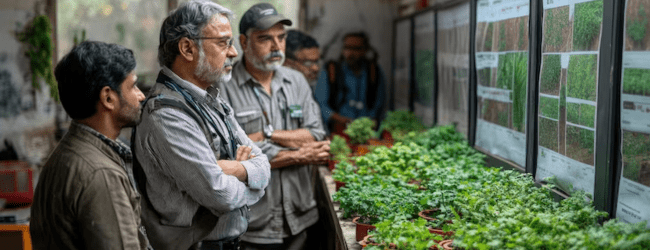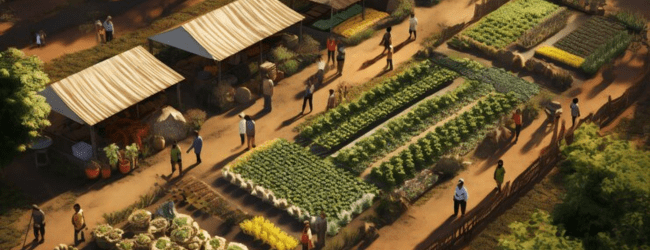Table of contents
“Commercial farming in India” is a significant aspect of the nation’s agricultural landscape, playing a crucial role in food production, economic growth, and rural livelihoods. Unlike traditional subsistence farming, commercial agriculture focuses on growing crops and raising livestock for profit, often on a large scale and utilising modern technologies and inputs. Let’s delve deeper into the types, advantages, challenges, and other important aspects of commercial farming in India.
What is Commercial Farming?

Commercial farming, also known as agribusiness, is a system of agriculture focused on producing crops and raising livestock for sale in the market to generate profit. It stands in contrast to subsistence farming, where the primary goal is to produce enough food to feed the farmer’s family.
Key Characteristics:
- Large-Scale Operations: Commercial farms typically operate on extensive land holdings to achieve economies of scale and maximise production.
- Profit-Oriented: The primary aim is to generate income by selling agricultural produce.
- High Capital Investment: It requires significant investment in:
- Land: Purchasing or leasing large areas of farmland.
- Machinery: Tractors, harvesters, planters, irrigation equipment, etc.
- Inputs: High-yielding variety (HYV) seeds, chemical fertilisers, pesticides, herbicides, animal feed, etc.
- Infrastructure: Storage facilities, processing units, transportation.
- Use of Modern Technology: Commercial farming heavily relies on advanced technologies and practices to enhance productivity and efficiency, including:
- Mechanisation: Extensive use of machinery for various farm operations.
- High-Yielding Varieties (HYV) of Seeds: Genetically improved seeds for increased output.
- Chemical Inputs: Fertilisers to boost soil nutrients and pesticides/herbicides to control pests and weeds.
- Irrigation Systems: Ensuring a consistent water supply, often through advanced methods like drip or sprinkler irrigation.
- Precision Farming: Utilising GPS, sensors, and data analytics to optimise resource use.
- Specialisation: Commercial farms often specialise in the cultivation of a single crop (like in plantation agriculture) or the rearing of a specific type of livestock to streamline operations and cater to market demands.
- Market Dependence: Commercial farmers are highly reliant on market prices and demand for their products.
- Year-Round Production: Unlike rain-fed subsistence farming, commercial agriculture often aims for continuous production throughout the year, facilitated by irrigation and modern techniques.
- Skilled Labour: While mechanisation reduces manual labour in some aspects, skilled labour is required for operating machinery, managing technology, and implementing scientific farming practices.
In essence, commercial farming is a business-oriented approach to agriculture where production is driven by market forces and the goal is to achieve high yields and profitability through the application of modern science, technology, and significant capital investment.
💡 Pro Tip: If you want to start a farming business but have too many doubts, connect with a farming business expert from Boss Wallah for guidance – Check Out
Types of Commercial Farming in India

India’s diverse agro-climatic conditions support various types of commercial farming. Some of the prominent ones include:
1. Commercial Grain Farming
- Focus: Large-scale cultivation of grains primarily for sale in the market. The main crops include wheat, rice, maize, and millets.
- Key Features:
- Extensive Land Use: Typically practised on large farms to achieve high production volumes.
- High mechanisation: Relies heavily on machinery for ploughing, sowing, harvesting, and threshing to manage large areas efficiently.
- Modern Inputs: Utilises high-yielding variety (HYV) seeds, chemical fertilisers, pesticides, and well-developed irrigation systems to maximise yields.
- Market-Oriented: The entire or a significant portion of the produce is intended for sale in regional or national markets.
- Regional Concentration in India:
- Wheat and Rice: Predominantly found in the fertile plains of Punjab, Haryana, and Uttar Pradesh. These regions have well-established irrigation infrastructure and have benefited significantly from the Green Revolution.
- Maize: Grown commercially in states like Karnataka, Andhra Pradesh, Rajasthan, and Uttar Pradesh, often used for feed and industrial purposes.
- Millets: While some millets are grown for subsistence, commercial cultivation occurs in states like Rajasthan (bajra), Maharashtra (jowar), and Karnataka (ragi), often suited to drier conditions.
2. Plantation Agriculture
- Focus: Growing a single cash crop on a large estate or “plantation” primarily for export or industrial use.
- Key Features:
- Large Estates: Requires vast tracts of land and significant capital investment for development and management.
- Single Crop Specialisation: Focuses on one major crop, leading to specialised knowledge and infrastructure for that particular crop.
- Management Structure: Often involves a hierarchical management system to oversee large labour forces and operations.
- Processing Facilities: Plantations may have their own processing units for initial treatment of the harvested produce.
- Prominent Plantation Crops and Regions in India:
- Tea: Concentrated in the hilly regions of Assam, West Bengal (Darjeeling), and the Nilgiri hills of South India. Requires specific climatic conditions (high rainfall, sloping terrain, and well-drained soil) and significant manual labour, especially for plucking.
- Coffee: Primarily grown in the hilly tracts of Karnataka (Kodagu, Chikmagalur, Hassan), Kerala (Wayanad), and Tamil Nadu (Nilgiris). Two main varieties, Arabica and Robusta, are cultivated based on altitude and climate.
- Rubber: Found mainly in Kerala, Tamil Nadu, Karnataka, and the Andaman and Nicobar Islands. Requires high rainfall and specific temperature conditions.
- Sugarcane: Grown commercially in Uttar Pradesh, Maharashtra, Tamil Nadu, Karnataka, and Andhra Pradesh. Often linked to sugar mills for processing.
- Other Plantation Crops: Include coconut (Kerala, Tamil Nadu), spices like cardamom and pepper (Kerala, Karnataka), and cashew (Maharashtra, Kerala, Tamil Nadu).
3. Horticulture
- Focus: Commercial cultivation of fruits, vegetables, flowers, ornamental plants, spices, and medicinal plants.
- Key Features:
- Diverse Range of Crops: Encompasses a wide variety of high-value crops catering to different market segments.
- Intensive Cultivation: Often requires intensive management practices, including careful irrigation, fertilisation, and pest control.
- Market Demand: Highly responsive to consumer preferences and market demand, including both domestic and export markets.
- Post-Harvest Management: Proper handling, storage, and transportation are crucial to maintain the quality and value of horticultural produce.
- Significant Horticultural Activities in India:
- Fruits: Mangoes (Andhra Pradesh, Maharashtra, Uttar Pradesh), grapes (Maharashtra), bananas (Tamil Nadu, Maharashtra), apples (Himachal Pradesh, Jammu & Kashmir), citrus fruits (Maharashtra, Andhra Pradesh).
- Vegetables: Potatoes, onions, tomatoes (various states with regional specialisation), cauliflower, cabbage, okra, etc.
- Flowers: Floriculture is a growing commercial activity, with states like Tamil Nadu, Karnataka, and Maharashtra being major producers of flowers like roses, jasmine, and marigolds.
- Spices: India is a major producer and exporter of various spices like chilli, turmeric, ginger, cardamom, and pepper, with Kerala being a significant hub.
4. Commercial Livestock Farming
- Focus: Raising animals on a large scale for commercial purposes, including meat, milk, eggs, and other animal products.
- Key Features:
- Large Herds/Flocks: Involves maintaining a significant number of animals to achieve commercial viability.
- Scientific Management: Employs modern breeding techniques, feeding practices, and disease control measures.
- Infrastructure: Requires investment in housing, feeding systems, and processing facilities (e.g., for dairy or meat).
- Market Linkages: Production is geared towards supplying urban markets, processing industries, and export channels.
- Key Areas of Commercial Livestock Farming in India:
- Dairy Farming: A significant commercial activity across India, with major cooperative movements like Amul playing a crucial role. Key dairy animals include cows and buffalo.
- Poultry Farming: Large-scale production of chickens, ducks, and other birds for meat and eggs, particularly concentrated around urban centres.
- Meat Production: Raising goats, sheep, pigs, and buffaloes for meat, with regional variations in preferred meats.
- Aquaculture (Fish Farming): Commercial cultivation of fish and other aquatic organisms in ponds, tanks, and other controlled environments to meet the growing demand for seafood.
5. Contract Farming
- Focus: A system where farmers enter into agreements with agri-business firms or processors to produce specific crops or livestock products under pre-defined conditions.
- Key Features:
- Pre-Harvest Agreements: Contracts specify the quantity, quality, price, and delivery schedule of the produce.
- Input and Technology Support: Firms may provide farmers with seeds, fertilisers, technical guidance, and sometimes even credit.
- Assured Market: Farmers have a guaranteed buyer for their produce, reducing market risks.
- Standardised Quality: Firms often enforce quality standards to ensure uniformity of the raw material.
- Examples in India: Common in crops like sugarcane (linked to sugar mills), vegetables (for processing industries), oilseeds, cotton, and poultry (integration with processing plants).
Understanding these different types of commercial farming provides a comprehensive view of the diverse agricultural activities contributing to India’s economy and food systems. Each type faces its own set of opportunities and challenges, influencing the livelihoods of farmers and the overall agricultural landscape.
Advantages of Commercial Farming in India

Commercial farming in India offers a multitude of advantages that contribute significantly to the nation’s economy, food security, and the livelihoods of farmers involved. Here’s a more detailed breakdown of these benefits:
1. Enhanced Productivity and Efficiency
- Higher Yields: The adoption of high-yielding variety (HYV) seeds, coupled with the use of chemical fertilisers, pesticides, and modern irrigation techniques, leads to significantly higher per-unit area production compared to traditional farming methods. This increased productivity is crucial for feeding India’s large and growing population.
- Example: The Green Revolution in India, which focused on commercial grain farming, dramatically increased wheat and rice production through the use of HYV seeds and modern inputs.
- Economies of Scale: Large-scale farming allows for the efficient utilisation of resources, including land, labour, and capital. Bulk purchasing of inputs often leads to cost savings per unit of output.
- Mechanisation: The use of machinery for various farm operations (ploughing, sowing, harvesting, processing) saves time and labour, improves efficiency, and allows for the timely completion of agricultural tasks, reducing post-harvest losses.
2. Economic Growth and Development
- Increased Farm Income: Higher yields and market-oriented production translate to increased income for farmers, leading to improved living standards and reduced rural poverty.
- Contribution to GDP: The commercial agriculture sector is a significant contributor to India’s Gross Domestic Product (GDP). Its growth has a cascading effect on other sectors like transportation, processing, and retail.
- Employment Generation: While often perceived as less labour-intensive per unit area than subsistence farming, commercial agriculture and its allied industries (e.g., input manufacturing, food processing, agricultural marketing) create numerous employment opportunities in rural and urban areas.
- Export Potential and Foreign Exchange Earnings: India’s diverse agro-climatic conditions allow for the commercial production of various crops and livestock products with significant export potential, earning valuable foreign exchange.
- Example: The export of basmati rice, spices, mangoes, and processed food products contributes to India’s foreign trade.
3. Improved Food Security
- Stable Food Supply: Large-scale commercial production ensures a more stable and consistent supply of food grains, fruits, vegetables, and animal products for the growing population, contributing to national food security.
- Market Availability: Commercial farming makes a wider variety of food products readily available in the market throughout the year, improving dietary diversity for consumers.
4. Technological Advancement and Modernisation
- Adoption of Modern Techniques: Commercial farming encourages the adoption of modern technologies like precision farming, biotechnology, and information technology in agriculture, leading to increased efficiency and sustainability.
- Research and Development: The focus on commercial viability often drives investment in agricultural research and development, leading to the development of new crop varieties, farming techniques, and pest management strategies.
5. Development of Allied Industries
- Growth of Agri-Business: Commercial agriculture fuels the growth of various agri-business sectors, including the manufacturing of fertilisers, pesticides, and farm machinery, as well as food processing, packaging, and marketing industries.
- Infrastructure Development: The need for efficient transportation, storage, and processing of commercial agricultural produce often leads to the development of crucial infrastructure in rural areas.
6. Better Market Linkages
- Integration with Supply Chains: Commercial farming often involves better integration with established supply chains, connecting producers directly with processors, retailers, and consumers, potentially reducing the role of intermediaries and improving price realisation for farmers.
- Contract Farming Benefits: As a form of commercial farming, contract farming provides farmers with assured markets and pre-determined prices, reducing market risks and facilitating access to technology and credit.
7. Improved Standard of Living for Farmers
- Higher Income and Investment Capacity: Increased profitability allows commercial farmers to invest more in their farms, adopt better technologies, educate their children, and access better healthcare, leading to an improved overall standard of living.
- Empowerment and Social Mobility: Successful commercial farming can empower farmers economically and socially, providing opportunities for upward mobility within their communities.
Challenges Faced by Commercial Farming in India

Despite its advantages, commercial farming in India faces several challenges:
1. High Input Costs
- Expensive Inputs: The cost of essential inputs like high-yielding variety (HYV) seeds, chemical fertilisers, pesticides, herbicides, and machinery can be prohibitively high for many farmers, especially small and marginal landholders. This can squeeze their profit margins and limit their ability to adopt modern farming practices.
- Dependence on Markets: Farmers are often dependent on volatile input markets, where prices can fluctuate significantly, further adding to their financial burden.
2. Dependence on Monsoon and Inadequate Irrigation
- Erratic Rainfall: A significant portion of Indian agriculture still relies on the monsoon, which is known for its variability and unpredictability. Droughts and floods can lead to massive crop losses, despite the adoption of commercial farming practices.
- Limited Irrigation Coverage: While irrigation infrastructure has improved, it is still not uniformly available across the country. Many commercial farms, especially those outside well-irrigated zones, remain vulnerable to rainfall deficits.
- Inefficient Water Management: Even where irrigation is available, inefficient water management practices, including over-extraction of groundwater and poorly maintained canals, can lead to water scarcity and environmental issues.
3. Lack of Adequate Infrastructure
- Poor Transportation Networks: Inadequate road connectivity and transportation facilities, especially in rural areas, hinder the timely movement of agricultural produce from farms to markets, leading to post-harvest losses and reduced prices for farmers.
- Insufficient Storage Facilities: The lack of sufficient and modern storage facilities, including cold storage for perishable goods, results in significant wastage of harvested crops, further impacting farmers’ income and overall food availability.
- Limited Market Access: Many farmers, particularly smallholders, lack direct access to organised markets and are often forced to sell their produce through intermediaries who may take a significant cut of the profits.
4. Price Volatility and Market Uncertainty
- Fluctuating Prices: The prices of agricultural commodities can fluctuate significantly due to various factors like oversupply, changes in demand, government policies, and global market trends. This price volatility creates uncertainty for commercial farmers and can lead to substantial income losses.
- Lack of Price Support Mechanisms: While the government provides Minimum Support Prices (MSPS) for certain crops, their effectiveness and reach can be limited, leaving farmers vulnerable to market price crashes.
5. Small and Fragmented Land Holdings
- Limited Scale of Operations: The average landholding size in India is relatively small, and further fragmentation due to inheritance laws limits the scope for large-scale mechanisation and efficient resource utilisation in commercial farming.
- Difficulty in Adopting Technology: Small landholdings can make it economically unviable for individual farmers to invest in expensive machinery and modern technologies.
6. Climate Change and Environmental Degradation
- Erratic Weather Patterns: Climate change is exacerbating weather unpredictability, leading to more frequent and intense droughts, floods, heatwaves, and unseasonal rainfall, all of which can severely impact crop yields and livestock production.
- Soil Degradation: Overuse of chemical fertilisers and pesticides, coupled with unsustainable farming practices, can lead to soil degradation, loss of soil fertility, and increased vulnerability to pests and diseases.
- Water Scarcity: Depleting groundwater levels and changing rainfall patterns are increasing water scarcity, posing a significant threat to irrigation-dependent commercial farming.
7. Access to Credit and Finance
- Limited Access to Formal Credit: Many small and marginal commercial farmers struggle to access formal credit from banks and financial institutions due to a lack of collateral, complex procedures, and high interest rates.
- Dependence on Informal Lenders: This often forces them to rely on informal moneylenders who charge exorbitant interest rates, pushing them into debt traps.
8. Lack of Awareness and Technology Adoption
- Limited Knowledge of Modern Practices: Some farmers may lack awareness and knowledge about the latest agricultural technologies, sustainable farming practices, and market trends.
- Slow Adoption of Technology: The adoption rate of advanced technologies like precision farming, automation, and ICT (Information and Communication Technology) in agriculture is still relatively slow, particularly among small-scale commercial farmers.
9. Pests and Diseases
- Increased Vulnerability: Large-scale monoculture, a common practice in commercial farming, can increase the vulnerability of crops to widespread pest and disease outbreaks, leading to significant losses if not managed effectively.
- Resistance to Pesticides: Over-reliance on chemical pesticides can lead to the development of pest resistance, requiring the use of more expensive and potentially harmful chemicals.
10. Social and Economic Disparities
- Regional Imbalances: The benefits of commercial farming have not been evenly distributed across all regions of India, leading to regional disparities in agricultural development and farmers’ income.
- Inequality: Small and marginal farmers often face greater challenges compared to large-scale commercial enterprises, exacerbating existing social and economic inequalities in rural areas.
ALSO READ | Mango Farming in India: Types, Investment, Profits & More
Government Initiatives to Promote Commercial Farming
The Indian government has implemented various schemes and policies to promote commercial farming and address the challenges faced by farmers. These include:
- Pradhan Mantri Krishi Sinchayee Yojana (PMKSY): Focuses on expanding irrigation coverage and improving water use efficiency.
- Soil Health Card Scheme: Provides farmers with information on the nutrient status of their soil and recommends appropriate fertiliser use.
- National Mission on Sustainable Agriculture (NMSA): Aims to promote sustainable agricultural practices.
- Pradhan Mantri Fasal Bima Yojana (PMFBY): Provides crop insurance to protect farmers against losses due to natural calamities.
- e-NAM (National Agriculture Market): An online trading platform to facilitate better price discovery and market access for farmers.
- Agricultural Infrastructure Fund: A medium-to-long-term debt financing facility for investment in post-harvest management infrastructure and community farming assets.
- Promotion of Farmer Producer Organisations (FPOs): Encouraging the formation of FPOs to enhance farmers’ collective bargaining power and market access.
ALSO READ | Precision Farming in India: Technology, Benefits & Market Potential
The Future of Commercial Farming in India
The future of commercial farming in India looks promising, with increasing demand for food due to a growing population and rising income levels. Technological advancements, precision farming techniques, and a greater focus on sustainable practices are expected to further enhance the efficiency and profitability of commercial agriculture. Strengthening infrastructure, improving market linkages, and empowering farmers with knowledge and resources will be crucial for realising the full potential of this vital sector.
Need Expert Guidance?
Starting a business can be challenging, but you don’t have to do it alone! At Boss Wallah, our 2,000+ business experts are ready to provide valuable insights and guidance. Whether you need help with marketing, finance, sourcing, or any other area of business, our business experts are here to help you succeed. Check Out
Confused about Which Business to Start?
Want to start your own business but unsure which one to choose? Explore Boss Wallah, where you’ll find 500+ courses by successful business owners, featuring practical, step-by-step guides on starting and growing various businesses.
Find your perfect business idea today – Check Out
Conclusion
Commercial farming in India is a dynamic and evolving sector with the potential to drive economic growth, ensure food security, and improve the livelihoods of millions. While challenges remain, ongoing government initiatives and the adoption of modern technologies offer a path towards a more efficient, sustainable, and profitable agricultural future. Understanding the types, advantages, and challenges of commercial farming is essential for policymakers, farmers, and other stakeholders to work collaboratively towards the progress of Indian agriculture.
Frequently Asked Questions (FAQs)
1 . What is the main difference between commercial farming and subsistence farming?
- Commercial farming is primarily focused on producing crops and livestock for sale and profit in the market, often on a large scale with modern inputs. Subsistence farming, on the other hand, is primarily aimed at producing enough food to meet the needs of the farmer’s family, with little or no surplus for sale.
2 . Which Indian states are known for commercial grain farming?
- Punjab, Haryana, and Uttar Pradesh are key states known for commercial grain farming, particularly wheat and rice.
3 . Can you give an example of a successful commercial horticulture venture in India?
- The cultivation and export of Alphonso mangoes from Maharashtra is a successful example of commercial horticulture. Farmers in this region have adopted modern farming practices and marketing strategies to cater to both domestic and international markets.
4 . What are the major inputs used in commercial farming?
- Major inputs include high-yielding variety (HYV) seeds, chemical fertilisers, pesticides, irrigation, and modern machinery.
5 . How does contract farming benefit small and marginal farmers?
- Contract farming can provide small and marginal farmers with assured income, access to technology and extension services, and a guaranteed market for their produce, reducing market risks.
6 . What are the main infrastructure challenges affecting commercial farming in India?
- Key infrastructure challenges include inadequate irrigation facilities, poor transportation networks, insufficient storage facilities, and limited access to organised markets.
7 . How does climate change impact commercial agriculture in India?
- Climate change can lead to erratic rainfall, droughts, floods, and changes in temperature, which can negatively affect crop yields, increase pest and disease outbreaks, and impact the overall productivity of commercial farms.
8 . What role do Farmer Producer Organisations (FPOs) play in promoting commercial farming?
- FPOs help farmers collectively access better quality inputs, negotiate better prices for their produce, access credit and market information, and reduce transaction costs, thereby promoting commercial viability.
9 . Is commercial livestock farming a significant contributor to the Indian economy?
- Yes, commercial livestock farming, particularly dairy and poultry, is a significant contributor to the Indian economy, providing livelihoods to millions and meeting the growing demand for animal products.
10 . What are some sustainable practices that can be adopted in commercial farming?
- Sustainable practices include integrated pest management (IPM), integrated nutrient management (INM), water-efficient irrigation techniques like drip and sprinkler irrigation, crop rotation, and the use of organic fertilisers.


